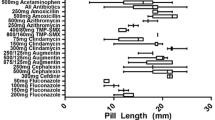Abstract
Objective: To determine whether large prescriptions (≥90 days’ supplies) enhance the acquisition of maintenance medications by patients.
Design: Study 1: multisite, retrospective cohort study evaluating outpatient digoxin use. Study 2: single-site, retrospective cohort study to confirm Study 1.
Setting: Study 1: Ten Veterans Affairs Medical Centers in the Rocky Mountain region. Study 2: The only facility from Study 1 (site C) that dispensed large prescriptions of maintenance medications.
Patients: Randomly selected outpatients receiving two or more digoxin prescriptions (n=176 in Study 1,n=114 in Study 2).
Intervention: None.
Results: The main outcome measure was the proportion of prescribed doses of maintenance medications obtained. In Study 1, patients who received at least one large digoxin prescription obtained a mean of 13 7.2% of their prescribed digoxin doses over a mean of nine months, compared with 91.3% for patients who received only small prescriptions of <90 days’ supplies (p=0.02). Patients receiving large prescriptions were more likely to obtain at least 100% of their prescribed amounts of digoxin (adjusted OR=11.4, 95% CI=1.3–96.8, p=0.03). At site C, patients in Study 1 obtained a mean of 129.0% of all maintenance drugs given in large supplies, compared with 95.2% of drugs prescribed only in small supplies (p=0.006). In Study 2, acquisition of digoxin increased progressively from 89.7% among individuals who received only small digoxin prescriptions to 113.0% for those who received only large supplies (p=0.002), over a mean of 14 months.
Conclusions: Large prescriptions facilitate the acquisition of maintenance medications but may lead to oversupplies, while small prescriptions impose a barrier to obtaining these drugs.
Similar content being viewed by others
References
Curtiss FR. Methods of providing prescription drug benefits in health plans. Am J Hosp Pharm. 1986;43:2428–35.
Horgan C, Knapp D. Study to Evaluate the Use of Mail Service Pharmacies. Springfield, VA: National Technical Information Service, 1989; NTIS publication no. PB90-172677.
Harris BL, Stergachis A, Ried LD. The effect of drug copayments on utilization and cost of Pharmaceuticals in a health maintenance organization. Med Care. 1990;28;907–17.
Kirking DM, Ascione FJ, Richards JW. Choices in prescription-drug benefit programs: mail versus community pharmacy services. Milbank Q. 1990;68:29–51.
Carlson KJ, Lee DC, Goroli AH, Leahy M, Johnson RA. An analysis of physicians’ reasons for prescribing long-term digoxin therapy in outpatients. J Chron Dis. 1985;38:733–9.
Steiner JF, Koepsell TD, Finn SD, Inui TS. A general method of compliance assessment using centralized pharmacy records: description and validation. Med Care. 1988;26:814–23.
Steiner, JF, Fihn SD, Blair B, Inui TS. Appropriate reductions in compliance among well-controlled hypertensive patients. J Clin Epidemiol. 1991;44:1361–71.
Diehr P, Grembowski D. A small area simulation approach to determining excess variation in dental procedure rates. Am J Public Health. 1990;80:1343–8.
Siegel S, Castellan NJ. Nonparametric Statistics for the Behavioral Sciences. New York: McGraw Hill, 1988; 123.
Hosmer DW, Lemeshow S. Applied Logistic Regression. New York: John Wiley, 1989;82–175.
Sueta CA, Carey TS, Burnett CK. Reassessment of indications for digoxin: are patients being withdrawn? Arch Intern Med. 1989;149:609–12.
Frazier LM, Brown JT, Divine GW, et al. Can physician education lower the cost of prescription drugs? A prospective, controlled trial. Ann Intern Med. 1991;115:116–21.
Stergachis A. Group Health Cooperative of Puget Sound. In: Strom BL (ed). Pharmacoepidemiology. New York: Churchill Livingstone, 1989;153.
Shulman NB, Martinez B, Brogan D, Carr AA, Miles CG. Financial cost as an obstacle to hypertension therapy. Am J Public Health. 1986;76:1105–8.
Author information
Authors and Affiliations
Additional information
Supported by the Veterans Health Services and Research Administration, Department of Veterans Affairs.
Rights and permissions
About this article
Cite this article
Steiner, J.F., Robbins, L.J., Roth, S.C. et al. The effect of prescription size on acquisition of maintenance medications. J Gen Intern Med 8, 306–310 (1993). https://doi.org/10.1007/BF02600143
Issue Date:
DOI: https://doi.org/10.1007/BF02600143




